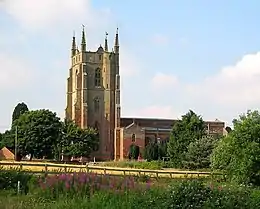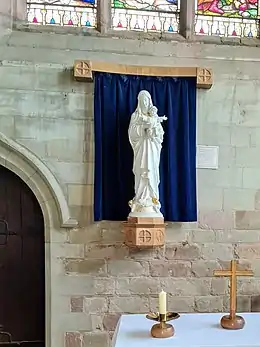Monks Kirby Priory
Monks Kirby Priory was a Benedictine priory established in 1077 in Monks Kirby, Warwickshire, England. The priory was suppressed in 1415 when its estates and revenues were given to the Carthusian priory of Axholme in Lincolnshire, in whose possession they continued until the Reformation. Remains of the priory form part of Monks Kirby village church today.

Foundation, 1077
Based on the very large size of the parish of Monks Kirby, the name of the village (kirk-by) and other indications (see Monks Kirby) the Church of Monks Kirby is understood to have been a minster in the Anglo-Saxon era.[1][2] After the Conquest, the land around Monks Kirby came into the ownership of Geoffrey de la Guerche, a Breton knight. Geoffrey rebuilt the Anglo Saxon church which had been "burst asunder", possibly in fighting between Saxons and Normans in the immediate post-Conquest period.[3]
Geoffrey established the rebuilt church as a alien priory subject to the Benedictine Abbey of St. Nicholas at Angers.[4] The text of the foundation charter for the priory survives, dated 1 July 1077.[5] A "remarkable" survival, it provides evidence of what is often assumed to have happened after the Conquest but is rarely clearly attested – a marriage between the new Norman lord of a territory, Geoffrey, and the daughter of the previous Anglo-Saxon lord, Ælgifu, daughter of Leofwin of Newnham.[6] Leofwin was a relative of Leofric, Earl of Mercia and his wife Lady Godiva.[7] Such a marriage would not imply that no violence had been done to Leofwin, or even to Ælgifu.[8]
In the charter, Geoffrey on behalf of Ælgifu and himself, granted to the new Priory the church of Kirby and two priests. He granted some of his local land (notably the village of Copston Magna) and the rights to other tithes and revenues from his estates across the country.[9] The Monks Kirby Priory was named in honour of the Virgin Mary and St Denis.[10] The Charter tells us the names of the first monks, brought from France – Geoffrey, Ranulf, Stephen, Maurice, Roger, and Herman. Based on their names, Herman may have been of Lotharingian origin, while the other five monks were French. The two priests, Frano and Osgot, are assumed to have been the priests of the pre-Conquest church. Like the village itself, they have Scandinavian names.[8]
The Benedictine priory
After Geoffrey's death, his estates, including the lands around Monks Kirby reverted to the King, who subsequently granted them to Nigel d'Aubigny, the father of Roger de Mowbray whose descendants were to become Earls of Nottingham and Dukes of Norfolk.
Through the 12th century, the priory grew in importance. New grants of land and revenues were given by the Mowbray family and others. No doubt the fact that the Plantagenet family – who came from Angers – had taken over the English throne increased Monks Kirby priory's profile. In the 1170s Richard of Waterville was a monk at Angers who was sent to become Prior of Monks Kirby. He went on to become Prior of Whitby where he played a key part in that town's establishment and is said to staged an archery competition for Robin Hood and Little John.[11]
In 1266 Henry III granted the monks a fair at Midsummer and a weekly market at Kirby.
Little is known of the layout of the monastery though it must have had a library and possibly a Scriptorium as one manuscript from the Priory is still in existence, a beautiful illuminated work from the late 12th century. The manuscript is now in the collection of Balliol College, Oxford (Balliol MS240). The Balliol manuscript includes a "Long account of how an image of the virgin and child in the church of Kirkebi frustrated two thieves one of whom was afterwards converted and paid regular annual visits to the Priory."[12]
The miracles attributed to the Virgin continued: around 200 years later, in 1360, the monks wrote to the Pope observing that "Christ has wrought many miracles in honour of His Mother in the church of the said priory."[13] The monks were writing to the Pope because the church was "old and in danger of ruin" and they wanted to raise money by granting generous penance to visiting pilgrims.[13] Through much of the 14th and early 15th centuries the Black Death and the Hundred Years War with France caused major problems for alien, French-run, priories like Monks Kirby. Money was short – the priory's estates were intermittently confiscated by the King[14] – and discipline was poor: in 1330 Monks Kirby's Benedictines had needed to be reminded of basic rules such as the non-admission of women to the monastery, and their duty to the poor.[13] Having nearly fallen into ruin, the church was substantially rebuilt in around 1380. The structure and shape of the church, as well as one of the church's bells, still in use today, dates from this reconstruction.[15]
In 1396, Thomas Mowbray, Earl of Nottingham wrote a letter to the Pope that has been summarised as saying: "The number of the monks at Kirby Priory, founded by his progenitor for seven monks, and subjected to the monastery of St Nicholas, Angiers, had long not been maintained, and only two monks resided (besides the prior); that the rule was not observed; that the goods were not expended for pious uses; that on account of the dissolute life of the prior and French monks living there, and of their servants, who were at discord with the English, and on account of the wars between the two realms, the buildings were partially falling." It is difficult to square Mowbray's letter with the fact the church had recently been almost entirely rebuilt, and perhaps, therefore, the letter exaggerated the situation in Mowbray's interests: he wished for the priory and its revenues to be transferred to the Carthusian Abbey he was establishing on the Isle of Axholme in Lincolnshire.[13]
Transfer to the Carthusians
In 1415 Henry V agreed that the Duke of Norfolk could transfer the priory and its lands out of nominally French hands, to become a house of the Carthusian Abbey established on the Duke's estates on the Isle of Axholme, Lincolnshire. By 1415 the connection between Monks Kirby and Axholme was already well over 300 years old as both formed part of the lands given to Geoffrey de la Guerche at the time of the Conquest and subsequently granted to the Mowbray family. The transfer represented a reversal: since 1077 revenues of Axholme had been paid to the priory of Monks Kirby, but now Monks Kirby revenues would support the new Axholme Abbey.
The church was again altered in the late fifteenth century, and an octagonal spire was added which must have been an imposing local landmark.
The Carthusians in Axholme practised a strict monastic lifestyle and the revenues of the Monks Kirby priory provided most of their income.[16] There were no monks now at Monks Kirby: in 1535 Axholme paid for a vicar at Monks Kirby and for a chantry priest; it is not known for whose soul or souls the chantry priest prayed.[17]
The Newnham Paddox Estate neighbouring Monks Kirby was owned by the Newnham family, under the Mowbrays, from the 12th century. The estate was held by a number of different families in the fourteenth and early fifteenth century until, on 11 November 1433, John Fildyng, or Feilding bought it. Fildyng was a descendent of the earlier owners, the Newnham family.[14][18] The Feildings expanded their estate by buying part of the Monks Kirby manor (i.e. the lands that belonged to Monks Kirby priory) from the monks at Axholme in 1515.[14]
The Reformation
At the Reformation, King Henry VIII confiscated the assets of the Axholme priory. The King granted the remaining lands of the Monks Kirby Manor to Thomas Manning, Bishop of Ipswich. Meanwhile, the King granted the rectory and the advowson of the vicarage and the income from the collection of local tithes to his foundation of Trinity College, Cambridge.
Post-Reformation

The priory church became the parish church of Monks Kirby.[20] Clear elements of the priory were incorporated into the north wall of the church and one of the two side chapels.
The manor of Monks Kirby did not stay with the Bishop of Ipswich. There were several owners over the following 80 years, including the family of Lady Jane Grey whose father, Henry, the first Duke of Suffolk probably paid for the impressive wooden ceiling still in place in the Church.[14] In the 1600s the Manor was bought by the powerful Countess of Buckingham who passed it to her grandson Basil Feilding, 2nd Earl of Denbigh (see Monks Kirby). The Feilding family thus came to own both the historic Newnham Paddox estate and the lands that in the medieval period had belonged to the Priory Church of Monks Kirby. The Earl of Denbigh owned most of the village and the land around it until the mid-twentieth century (see Monks Kirby).
The church spire blew down in 1701.[21] The distinctive parapets were added in the late eighteenth century and the church owes much of its current interior appearance to its most recent major restoration, in 1869.[18] The church's dedication to Saint Edith of Polesworth was almost certainly revived in the eighteenth century (see the article on church dedications), but the presumed medieval or Anglo-Saxon origins of the dedication to St Edith - while generally accepted - are unclear.[22]
Trinity College divested itself of substantial landholdings around Monks Kirby following the Second World War, but retains the benefice and continues to be involved in the church's affairs.[23]
Legacy
In 1977, the 900th anniversary of the foundation of the Priory was celebrated in Monks Kirby. The celebrations included a visit to the Church by Benedictine monks. In the 19th century, a Roman Catholic religious community had been re-established in Monks Kirby (see Monks Kirby Roman Catholic Community), and the celebrations involved both the Catholic and Anglican community.[24]
Notes
- Jones n.d., p. 9.
- Bassett 2001, p. 28.
- Greenway 1996 argues that the word dirupta in the Priory's foundation document means "shattered" or "burst asunder" and therefore implies a violent destruction of the Anglo-Saxon church. Previous translators have wrongly translated the word as "decayed" or "damaged".
- Monks Kirby was not the only English cell of this French priory, Spalding Priory in Lincolnshire was also transferred to be a house of St Nicholas at Angers, in 1074, three years before the founding of Kirby Priory.
- Dugdale 1655 The text of the charter survives but not the manuscript. The great historian of Warwickshire, Dugdale, ensured its survival by reproducing it from a manuscript in the Cotton Library which has since been lost or destroyed.
- Stenton 1944, p. 6.
- Keats-Rohan 1989 See family trees in Tables 1 and 2 on pages 292 and 302
- Greenway 1996.
- Geoffrey probably fought in the Battle of Hastings and was rewarded by William the Conqueror with "manors distributed over 6 counties, effectively grouped round four centres: Monks Kirby in east Warwickshire; Melton Mowbray in Leicestershire; Epworth in the Isle of Axholme, and Gainsborough in Lincolnshire." Timmins n.d.
- Though there is no evidence the name St Denis was ever used subsequently. Medieval sources refer principally to Kirkebi Monachorum (Kirby Priory), sometimes to St Nicholas' Priory (the name of the mother house in France), once (in a letter from the Pope) to St Benedict's priory and – possibly – once to St Edith's church. Frequently, documents associate the Priory with the Virgin Mary as the church was a centre of Marian devotion and pilgrimage.
- Charlton 1799, pp. 144, 147.
- Mynors 1963, p. 240.
- Victoria County History: Warks 1908.
- Victoria County History: Warks 1951.
- Church Bells of Warwickshire 2021.
- Victoria County History: Lincs 1906.
- Victoria County History: Warks 1951: "With the priory it [the Advowson of the Vicarage] passed to the Carthusians of Axholme, who in 1535 were paying a yearly stipend of £20 to the vicar, and £5 6s. 8d. to the priest of a chantry, of which the foundation and history are unknown."
- Kellys 1912.
- Sign in Monks Kirby Church 1977.
- Historic England & 1034855.
- Twenty feet of the spire was removed in 1630 to save on maintenance costs and the remainder then blew down at some point in the early 18th century, probably Christmas night 1701 (The 1912 Kelly's Directory records an inscription on the church roof reading "This roof was beat down.. ..the 25th December 1701"; the pamphlet produced at the time of the Church's 900s anniversary in 1977 also says 1701. However, the second, updated edition of Dugdale's History of Warwickshire, published in 1730, says the remainder of the spire blew down on Christmas Night 1722 and - most confusingly - that it was subsequently restored.) Kellys 1912 Dugdale & Thomas 1730
- Dugdale in 1656 references an Exchequer document from 1291, presumably a version of the Taxatio Ecclesiastica, which gives the name St Edith as that of the parish church. This Dugdale reference - which is not mentioned in other sources on Monks Kirby or modern published editions of the Taxatio- may well have been the basis for the eighteenth century revival of the St Edith's name.
- Trinity College 2013.
- St Edith's Church Festival Committee 1977.
References
- Bassett, Steven (2001). Anglo-Saxon Coventry and its churches. Stratford-upon-Avon, Warwickshire: Dugdale Society in association with the Shakespeare Birthplace Trust. ISBN 0-85220-078-1. OCLC 48586843.
- Charlton, Lionel (1799). The history of Whitby, and of Whitby abbey, before the conquest. York – via Google Books.
- Church Bells of Warwickshire 2021 "Monks Kirby". Church Bells of Warwickshire. 26 August 2021. Retrieved 26 December 2021.
- Dugdale, William (1655). "Priory of Monks Kirby, in Warwickshire". Monasticon Anglicanum: A History of the Abbies and Other ... Volume 6, Part 2 (in Latin). p. 996.
- Dugdale, William; Thomas, William (1730). The Antiquities of Warwickshire Illustrated... (2nd ed.). p. 77. Retrieved 21 November 2021.
- Greenway, Diana (1996). "Conquest and Colonization: The Foundation of an Alien Priory, 1077". In Blair & Golding (eds.). The Cloister and the World: Essays in Medieval History in Honour of Barbara Harvey.
- Historic England. "Church of St Edith (1034855)". National Heritage List for England. Retrieved 16 October 2014.
- Jones, Graham (n.d.). The origins of Leicestershire: churches, territories, and landscape. p. 9.
- Keats-Rohan, K. S. B. (1989). "The Making of Henry of Oxford: Englishmen in a Norman World" (PDF). Oxoniensia. 55: 287–310. ISSN 0308-5562.
- Kellys 1912 "Monks Kirby". Kelly's Directory of Warwickshire. 1912. p. 197. Retrieved 21 November 2021 – via University of Leicester Special Collections Online.
- Mynors, Sir Roger (1963). "240 Miscellenea". Catalogue of the Manuscripts of Balliol College Oxford, Oxford. Clarendon Press. p. 260. Retrieved 7 January 2021 – via Balliol College Archives.
- R. (1861). "Waterville family (letter to editor from anonymous writer)". Notes and Queries. ser. 2. 11 (267): 118. doi:10.1093/nq/s2-xi.267.118d.
- St Edith's Church, Monks Kirby (sign in Skipwith Side Chapel) (label next to statue). Retrieved 19 April 2022.
- St Edith's Church Monks Kirby 1077 1977 (booklet produced by the church at the time of its 900th anniversary). Lutterworth: St Edith's Church Festival Committee (1977). 1977.
- Stenton, F. M. (1944). "Presidential Address: English Families and the Norman Conquest". Transactions of the Royal Historical Society. Cambridge University Press (CUP). 26: 1–12. doi:10.2307/3678529. ISSN 0080-4401. JSTOR 3678529.
- Timmins, E. W (n.d.). Historical Notes the Manor of Crick - 2 (PDF). West Northamptonshire Local History.
- Trinity College (2013). "The College Livings". A Guide to Trinity College Chapel (PDF). Trinity College, Cambridge. p. 47.
- Victoria County History: Lincs 1906 Page, William, ed. (1906). "House of Carthusian Monks: the Priory of Axholme". A History of the County of Lincolnshire. Vol. 2. Victoria County History. pp. 158–160. Retrieved 20 December 2021 – via British History Online.
- Victoria County History: Warks 1908 Page, William, ed. (1908). "Alien houses: Priory of Monks Kirby". A History of the County of Warwick. Vol. 2. Victoria County History. pp. 129–131. Retrieved 10 December 2021 – via British History Online.
- Victoria County History: Warks 1951 Salzman, L.S., ed. (1951). "Parishes: Monks Kirby". A History of the County of Warwick. 6, Knightlow Hundred. Victoria County History. pp. 173–181. Retrieved 1 January 2021 – via British History Online.
